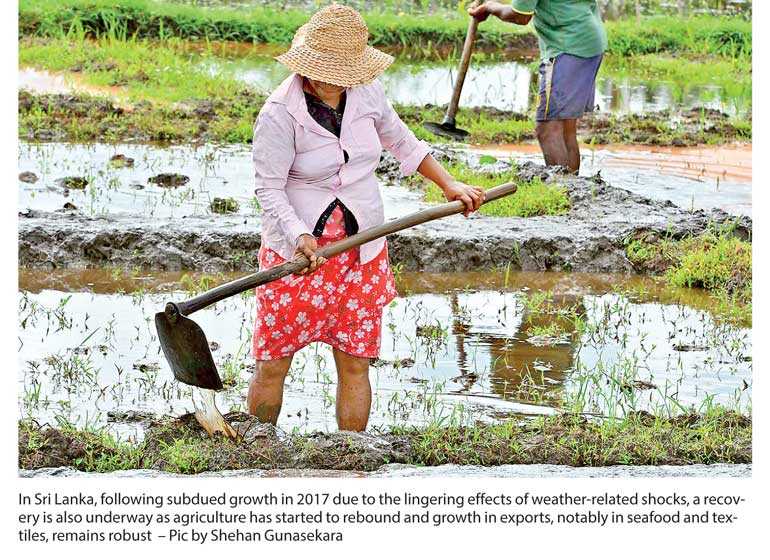Saturday Nov 29, 2025
Saturday Nov 29, 2025
Friday, 11 May 2018 00:10 - - {{hitsCtrl.values.hits}}


 The IMF has just released its Regional Economic Outlook (REO). According to the report the Asia-Pacific region remains the main engine of the global economy, and near-term prospects have improved since our last regional economic report, in October 2017.
The IMF has just released its Regional Economic Outlook (REO). According to the report the Asia-Pacific region remains the main engine of the global economy, and near-term prospects have improved since our last regional economic report, in October 2017.
But risks lurk on the horizon, including a tightening of global financial conditions, a shift toward protectionist policies, and an increase in geopolitical tensions. In addition, over the longer run, Asian economies continue to face major challenges from population aging and slowing productivity growth, as well as the rise of the digital economy, which could yield huge benefits but also bring major disruptions.
Given the many uncertainties, macroeconomic policies should remain prudent and aimed at building buffers and increasing resilience, while taking advantage of strong economic conditions to implement structural reforms to promote sustainable and inclusive growth.
Regional growth is expected to remain strong at 5.6% in 2018 and 2019—up by about 0.1 percentage points from our previous forecast—supported by strong global demand and favourable financial conditions.
As in other regions, inflation in Asia has largely remained subdued despite the pickup in growth. We project that inflation will remain at 1.4% on average in advanced economies and 3.3% on average in emerging markets. Among the larger economies, China’s growth for 2018 is projected to ease to 6.6% from 6.9% in 2017, as financial, housing, and fiscal tightening measures take effect.
Growth in Japan has been above potential for since spring 2016 and is expected to remain strong this year at 1.2%. And in India, after temporary disruptions caused by the currency exchange initiative and the rollout of the new Good and Services Tax, growth is expected to recover to 7.4%, making it once again the region’s fastest growing economy.
Risks to near-term growth are balanced, but downside risks prevail over the medium term. On the upside, the global recovery could again prove stronger than expected. New multi-lateral trade agreements and successful implementation of China’s Belt and Road Initiative—assuming debt sustainability and project quality are maintained—could support trade, investment, and growth.
Asia, however, remains vulnerable to a sudden and sharp tightening in global financial conditions, while extended periods of easy financial conditions could risk a buildup of leverage and financial vulnerabilities.
More inward-looking policies in major global economies, as highlighted by recent tariff actions and announcements, could disrupt international trade and financial markets and have a substantial impact on Asia, which has benefited so much from economic integration. Finally, geopolitical tensions could have serious financial and economic repercussions.
In Sri Lanka, following subdued growth in 2017 due to the lingering effects of weather-related shocks, a recovery is also underway as agriculture has started to rebound and growth in exports, notably in seafood and textiles, remains robust.
Real GDP growth is expected to reach 4% and inflation to remain below 5% in 2018. However, the economy remains vulnerable to adverse domestic and external shocks, given the still sizable public debt, large refinancing needs, and low external buffers.
Over the longer run, growth prospects for Asia will be heavily affected by demographics, slowing productivity growth, and the rise of the digital economy. Population ageing is an important challenge, as many economies face the risk of “growing old before they grow rich,” and the adverse effect of ageing on growth and fiscal positions could be substantial. A second challenge is slowing productivity growth.
Finally, the global economy is becoming increasingly digitalised, and while some recent advances could be truly transformative, they also bring challenges, including those related to the future of work. Asia is embracing the digital revolution, albeit with significant heterogeneity across the region.
The current strong economic outlook offers an opportunity to focus on building buffers, increasing resilience, and ensuring sustainability. In many countries in the region, continued fiscal support is less urgent given strong economic performance, and policymakers should focus on ensuring that debt remains under control. Some countries should also focus on revenue mobilisation to create space for infrastructure and social spending and to support structural reforms.
Sri Lanka has achieved major milestones in this area, including with the implementation of the new Inland Revenue Act. Further revenue mobilisation can make space for social and infrastructure spending while reducing the country’s still high public debt. Reforms of State-Owned Enterprises (SOEs), including progress with energy pricing reforms, are also critical to minimise fiscal risks, while greater exchange rate flexibility and reserve buffers would strengthen resilience against external shocks.
As for monetary policy, in much of the region, the policy stance can remain accommodative given that inflation is generally still muted. Nonetheless, central banks should be vigilant, since our analysis suggests that much of the undershooting of inflation targets in Asia can be explained by temporary, global factors, such as commodity prices and imported inflation, which could reverse. In the case of Sri Lanka, the Central Bank of Sri Lanka should continue to monitor closely risks arising from global economic developments and the domestic fiscal front, and adjust as needed the monetary stance to reflect evolving macroeconomic conditions.
Finally, tailored measures are needed to boost productivity and investment; narrow gender gaps in labour force participation; deal with the demographic transition; address climate change; and support those affected by shifts in technology and trade. And to reap the full benefits of the digital revolution, Asia will need a comprehensive and integrated policy strategy covering information and communications technology, infrastructure, trade, labour markets, and education.
In Sri Lanka, the authorities have recently developed their ‘Vision 2025,’ a three-year economic delivery program to promote Sri Lanka’s transition to a higher income status.
The authorities should push ahead with their ‘Vision 2025’ objectives, by further advancing fiscal consolidation through stronger fiscal rules and SOE governance; modernising monetary and exchange rate frameworks; accelerating their inclusive growth reform agenda, through trade liberalisation, climate budgeting, and greater female labour force participation, as well as better-targeted social protection programs.
Keeping the reform momentum is key to increase Sri Lanka’s resilience to external shocks and lay the foundation for more sustainable and inclusive growth.
(Manuela Goretti is Deputy Division Chief in the Asia and Pacific Department of the International Monetary Fund. Since February 2018, she is the IMF Mission Chief for Sri Lanka. Before assuming this position, she was Advisor to the First Deputy Managing Director of the IMF. She had previously worked as Deputy Unit Chief in the Risk Management Unit, as well as in the European and Strategy, Policy, and Review Departments of the IMF, with several surveillance and program assignments in emerging markets and the Euro Area. Prior to joining the Fund, she was a visiting scholar at the University of Wisconsin, Madison. She has a Ph.D. in Economics from Warwick University, UK.)